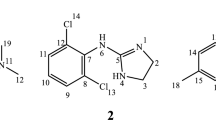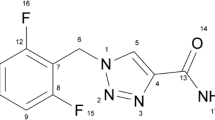Abstract
Purpose. In the route of developing novel liquid phase formulations based on the encapsulation of busulfan into liposomes in nontoxic solvents, drug crystallization inevitably occurs. In order to better understand the reactivity of busulfan, the characterization of its molecular properties was therefore considered as a key point. Also, preliminary attempts to prevent crystallization using cyclodextrins were explored.
Methods. An accurate single-crystal high-resolution X-ray diffraction experiment at 100 K has been carried out. The experimental electron density of busulfan was refined using a multipole model. Busulfan/β-cyclodextrin coprecipitates were analyzed by powder X-ray diffraction and 1H-NMR spectroscopy.
Results. The electrostatic properties of busulfan and the methylsulfonate fragment dipole moment (3.2 D) were determined. The polar moieties play a key role in the crystallization of busulfan, which presents a nucleophilic region surrounding the sulfonate part, whereas the carbon chain displays an electrophilic character. This highlights the subtle busulfan/β-cyclodextrin association.
Conclusions. Busulfan electrostatic properties were used to quantify its chemical reactivity. This explains the difficulty to formulate busulfan into liposomes due to a strong polar character of the methylsulfonate terminal groups. The complexation with cyclodextrins deserves to be further investigated to allow the formulation of busulfan in nontoxic solvents.
Similar content being viewed by others
References
D. A. G. Galton. Myleran in chronic myeloid leukemia: results of treatment. Lancet 1:208-213 (1953).
L. B. Grochow, R. J. Jones, R. B. Brundrett, H. G. Braine, T. L. Chen, R. Saral, G. W. Santos, and O. M. Colvin. Pharmacokinetics of busulfan: correlation with veno-occlusive disease in patients undergoing bone marrow transplantation. Cancer Chemother. Pharmacol. 25:55-61 (1989).
G. Vassal, S. Koscielny, D. Challine, D. Valteau-Couanet, I. Boland, A. Deroussent, J. Lemerle, A. Gouyette, and O. Hartmann. Busulfan disposition and hepatic veno-occlusive disease in children undergoing bone marrow transplantation. Cancer Chemother. Pharmacol. 37:247-253 (1996).
F. Baron, M. Deprez, and Y. Beguin. The veno-occlusive disease of the liver. Haematologica 82:718-725 (1997).
E. Olavarria, M. Hassan, A. Eades, C. Nilsson, A. Timms, J. Matthews, C. Craddock, E. Kanfer, J. Apperley, and J. Goldman. A phase I/II study of multiple-dose intravenous busulfan as myeloablation prior to stem cell transplantation. Leukemia 14:1954-1959 (2000).
R. Mackenna, S. Neidle, R. Kuroda, and B. W. Fox. Structures of three DNA cross-linking agents, ethane-1,2-di(methylsulfonate), propane-1,3-di(methylsulfonate) and n-butane-1,4-di(methylsulfonate). Acta Crystallogr. C45:311-314 (1989).
R. F. W. Bader. Atoms in Molecules: A Quantum Theory. Clarendon Press, Oxford, 1990.
K. H. Frömming and J. Szejtli (eds). Cyclodextrins in Pharmacy. Topics in Inclusion Science, Vol. 5, Kluwer Academic Publishers, Dordrecht; Boston., 1994.
J. Szejtli. Introduction and general overview of cyclodextrin chemistry. Chem. Rev. 98:1743-1753 (1998).
J. Bouligand. Développement de nanosphères furtives de busulfan. DEA Report. Université Paris V. (2001).
Siemens (BRUKER-AXS) Analytical X-ray Instruments Inc. SAINT (6.36A) and SADABS (2.05). Data Collection and Processing Software for the SMART System (5.054). Siemens, Madison, WI, 1998.
R. H. Blessing. Outlier treatment in data merging. J. Appl. Crystallogr. 30:421-426 (1997).
J. Rodriguez-Carvajal. Recent advances in magnetic structure determination by neutron powder diffraction. Physica B. 192:55-69 (1993).
G. M. Sheldrick. SHELXL97 and SHELXS97: Program for the refinement of crystal structures. University of Göettingen, Germany. (1997).
L. J. Farrugia. WINGX suite for small-molecule single-crystal crystallography. J. Appl. Crystallogr. 32:837-838 (1999).
N. K. Hansen and P. Coppens. Testing aspherical atom refinements on small-molecule data sets. Acta Crystallogr. A34:909-921 (1978).
E. Clementi and C. Roetti. Atomic data and nuclear data tables, Academic Press, New York 14:177-178 (1974).
E. Clementi and D. L. Raimondi. Atomic screening constants for SCF functions. J. Chem. Phys. 38:2686-2689 (1963).
P. Coppens, T. N. Guru, P. Leung, E. D. Stevens, P. Becker, and Y. W. Yang. Net atomic charges and molecular dipole moments from spherical-atom X-ray refinements, and the relation between atomic charge and shape. Acta Crystallogr. A35:63-72 (1979).
M. N. Burnett and C. K. Johnson. ORTEP-III report ORNL-6895. Oak Ridge International Laboratory, Tennessee. (1996).
N. E. Ghermani, N. Bouhmaida, and C. Lecomte. ELECTROS, STATDENS, FIELD+: Computer programs to calculate electrostatic properties from high resolution X-ray diffraction. Internal report UMR CNRS 7036, Université Henri Poincaré, Nancy 1, France; MR CNRS 8612, Université Paris XI, France; UMR CNRS 8612 Université Cadi Ayyad, Morocco. (dy1992–2003).
M. Souhassou. Atomic Properties from Experimental Electron Densities: Program Newprop-Int, 19th European Crystallographic Meeting, Nancy, France, August 25–31 2000, Abstract N° S2-m2-p2, P. 195 (also LCM3B Internal Report, Université Henri Poincaré, Nancy 1, France).
Y. A. Abramov. On the possibility of kinetic energy density evaluation from the experimental electron-density distribution. Acta Crystallogr. A53:264-272 (1997).
N. Bouhmaida, N. E. Ghermani, C. Lecomte, and A. Thalal. Molecular fragment electric moments derived from the fit of the experimental electrostatic potential. Application to the water molecule. Acta Crystallogr. A55:729-738 (1999).
F. H. Allen. The Cambridge Structural Database: a quarter of a million crystal structures and rising. Acta Crystallogr. B58:380-388 (2002).
D. Cruickshank and M. Eisenstein. The role of d functions in ab-initio calculations. Part 1. The deformation densities of H3NSO3 and SO3 -. J. Mol. Struct. 130:143-156 (1985).
B. Dittrich, T. Koritsánszky, M. Grosche, W. Scherer, R. Flaig, A. Wagner, H. G. Krane, H. Kessler, C. Riemer, A. M. M. Schreurs, and P. Luger. Reproducability and transferability of topological properties; experimental charge density of the hexapeptide cyclo-(D,L-Pro)2-(L-Ala)4 monohydrate. Acta Crystallogr. B58:721-727 (2002).
I. Rozas and D. F. Weaver. Ab-initio study of the methylsulfonate and phenylsulfonate anions. J. Chem. Soc. Perkin Trans. 2 3:461-466 (1996).
A. Abramov, A. V. Volkov, and P. Coppens. On the evaluation of molecular dipole moments from multipole refinement of X-ray diffraction data. Chem. Phys. Lett. 311:81-86 (1999).
D. Lide (ed). Handbook of Chemistry and Physics, 77th ed. CRC, New York. (1996).
T. Steiner and G. Koellner. Crystalline β-cyclodextrin hydrate at various humidities: fast, continuous, and reversible dehydration studied by X-ray diffraction. J. Am. Chem. Soc. 116(12):5122-5128 (1994).
Author information
Authors and Affiliations
Corresponding author
Rights and permissions
About this article
Cite this article
Ghermani, N.E., Spasojević-de Biré, A., Bouhmaida, N. et al. Molecular Reactivity of Busulfan Through Its Experimental Electrostatic Properties in the Solid State. Pharm Res 21, 598–607 (2004). https://doi.org/10.1023/B:PHAM.0000022406.04888.f1
Issue Date:
DOI: https://doi.org/10.1023/B:PHAM.0000022406.04888.f1




